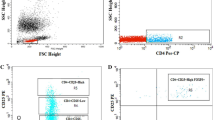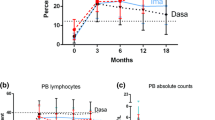Abstract
Several retrospective studies in children with B cell precursor (BCP) acute lymphoblastic leukemia (ALL) provided clinical evidence that higher absolute lymphocyte counts (ALC) early into treatment significantly correlated with improved relapse-free and overall survival. It still remains unknown, however, whether the predictive role of higher ALCs reflects general bone marrow recovery or a more specific attribute of immune function. To investigate this question, we implemented a prospective observational cohort study in 20 children with BCP ALL on day 29 (D29) of induction chemotherapy and immunophenotyped their lymphoid (T, B and natural killer cells) and myeloid (neutrophils, monocytes, dendritic cells) compartments. In a first evaluation of a cohort treated with Children’s Oncology Group-based induction chemotherapy, the immune cell compartments were differentially depleted at D29. Neither gender, risk status, minimal residual disease, nor bone marrow recovery markers correlated with D29 ALC. In contrast, both CD3+ T cell and dendritic cell compartments, which did not correlate with age, significantly correlated with D29 ALC (p < 0.0001). In addition, subset complexity of cellular immune compartments was preserved at D29. This study reveals that D29 ALC significantly correlates with distinct immune cell compartments but not with bone marrow recovery markers, suggesting that higher D29 ALCs may contribute to leukemia control by inducing specific host immune activity.





Similar content being viewed by others
Abbreviations
- ALC:
-
Absolute lymphocyte count
- ALL:
-
Acute lymphoblastic leukemia
- AMC:
-
Absolute monocyte count
- ANC:
-
Absolute neutrophil count
- BCP:
-
B cell precursor
- CBC:
-
Complete blood cell count
- COG:
-
Children’s Oncology Group
- D0:
-
Day 0 at diagnosis before chemotherapy
- D29:
-
End of induction chemotherapy day 29
- HR:
-
High-risk
- mDCs:
-
Myeloid dendritic cells
- NKs:
-
Natural killer cells
- pDCs:
-
Plasmacytoid dendritic cells
- SR:
-
Standard-risk
- WBC:
-
White blood cell count
References
Hunger SP, Mullighan CG (2015) Acute lymphoblastic leukemia in children. N Engl J Med 373:1541–1552
Pui C-H, Yang JJ, Hunger SP et al (2015) Childhood acute lymphoblastic leukemia: progress through collaboration. J Clin Oncol 33:2938–2948
Borowitz MJ, Devidas M, Hunger SP et al (2008) Clinical significance of minimal residual disease in childhood acute lymphoblastic leukemia and its relationship to other prognostic factors: a Children’s Oncology Group study. Blood 111:5477–5485
Schrappe M (2014) Detection and management of minimal residual disease in acute lymphoblastic leukemia. Hematology 2014:244–249
De Angulo G, Yuen C, Palla SL et al (2008) Absolute lymphocyte count is a novel prognostic indicator in ALL and AML: implications for risk stratification and future studies. Cancer 112:407–415
Rabin KR, Gramatges MM, Borowitz MJ et al (2012) Absolute lymphocyte counts refine minimal residual disease-based risk stratification in childhood acute lymphoblastic leukemia. Pediatr Blood Cancer 59:468–474
Rubnitz JE, Campbell P, Zhou Y et al (2013) Prognostic impact of absolute lymphocyte counts at the end of remission induction in childhood acute lymphoblastic leukemia. Cancer 119:2061–2066
Hatzipantelis E, Pana ZD, Vlachou M et al (2014) Peripheral blood lymphocyte recovery and overall survival in pediatric acute lymphoblastic leukemia. Pediatr Blood Cancer 61:181–183
Gupta A, Kapoor G, Jain S, Bajpai R (2015) Absolute lymphocyte count recovery independently predicts outcome in childhood acute lymphoblastic leukemia: experience from a tertiary care cancer center of a developing country. J Pediatr Hematol Oncol 37:e143–e149
Hirase S, Hasegawa D, Takahashi H et al (2015) Absolute lymphocyte count at the end of induction therapy is a prognostic factor in childhood acute lymphoblastic leukemia. Int J Hematol 102:594–601
Cheng Y, Luo Z, Yang S et al (2015) The ratio of absolute lymphocyte count at interim of therapy to absolute lymphocyte count at diagnosis predicts survival in childhood B-lineage acute lymphoblastic leukemia. Leuk Res 39:144–150
Shen HQ, Feng JH, Tang YM et al (2013) Absolute lymphocyte count is associated with minimal residual disease level in childhood B-cell precursor acute lymphoblastic leukemia. Leuk Res 37:671–674
Behl D, Porrata LF, Markovic SN et al (2006) Absolute lymphocyte count recovery after induction chemotherapy predicts superior survival in acute myelogenous leukemia. Leukemia 20:29–34
Rabin KR, Gramatges MM, Margolin JF, Zweidler-McKay PA (2014) Reply to “Peripheral blood lymphocyte recovery and overall survival in pediatric acute lymphoblastic leukemia”. Pediatr Blood Cancer 61:180
Maecker B, Mougiakakos D, Zimmermann M et al (2006) Dendritic cell deficiencies in pediatric acute lymphoblastic leukemia patients. Leukemia 20:645–649
Laane E, Bjorklund E, Mazur J et al (2007) Dendritic cell regeneration in the bone marrow of children treated for acute lymphoblastic leukaemia. Scand J Immunol 66:572–583
Eyrich M, Wiegering V, Lim A et al (2009) Immune function in children under chemotherapy for standard risk acute lymphoblastic leukaemia—a prospective study of 20 paediatric patients. Br J Haematol 147:360–370
van Tilburg CM, van der Velden VHJ, Sanders EAM et al (2011) Reduced versus intensive chemotherapy for childhood acute lymphoblastic leukemia: impact on lymphocyte compartment composition. Leuk Res 35:484–491
Wiegering V, Frank J, Freudenberg S et al (2014) Impaired B-cell reconstitution in children after chemotherapy for standard or medium risk acute precursor B-lymphoblastic leukemia. Leuk Lymphoma 55:870–875
Blimkie D, Fortuno ES, Yan H et al (2011) Variables to be controlled in the assessment of blood innate immune responses to Toll-like receptor stimulation. J Immunol Methods 366:89–99
Valle A, Maugeri N, Manfredi AA, Battaglia M (2012) Standardization in flow cytometry: correct sample handling as a priority. Nat Rev Immunol 12:864
Autissier P, Soulas C, Burdo TH, Williams KC (2010) Evaluation of a 12-color flow cytometry panel to study lymphocyte, monocyte, and dendritic cell subsets in humans. Cytometry A 77:410–419
Maecker HT, McCoy JP, Nussenblatt R (2012) Standardizing immunophenotyping for the Human Immunology Project. Nat Rev Immunol 12:191–200
Tosato F, Bucciol G, Pantano G et al (2015) Lymphocytes subsets reference values in childhood. Cytom Part A 87:81–85
Heinze A, Elze MC, Kloess S et al (2013) Age-matched dendritic cell subpopulations reference values in childhood. Scand J Immunol 77:213–220
Flohr T, Schrauder A, Cazzaniga G et al (2008) Minimal residual disease-directed risk stratification using real-time quantitative PCR analysis of immunoglobulin and T-cell receptor gene rearrangements in the international multicenter trial AIEOP-BFM ALL 2000 for childhood acute lymphoblastic leukemia. Leukemia 22:771–782
Ravandi F, Jorgensen JL, O’Brien SM et al (2016) Minimal residual disease assessed by multi-parameter flow cytometry is highly prognostic in adult patients with acute lymphoblastic leukaemia. Br J Haematol 172:392–400
Berry DA, Zhou S, Higley H et al (2017) Association of minimal residual disease with clinical outcome in pediatric and adult acute lymphoblastic leukemia: a meta-analysis. JAMA Oncol 3(7):e170580
Geissmann F, Manz MG, Jung S et al (2010) Development of monocytes, macrophages, and dendritic cells. Science 327:656–661
Sun D, Elson P, Liedtke M et al (2012) Absolute lymphocyte count at day 28 independently predicts event-free and overall survival in adults with newly diagnosed acute lymphoblastic leukemia. Am J Hematol 87:957–960
Yanada M, Borthakur G, Garcia-Manero G et al (2008) Blood counts at time of complete remission provide additional independent prognostic information in acute myeloid leukemia. Leuk Res 32:1505–1509
Cox MC, Nofroni I, Ruco L et al (2008) Low absolute lymphocyte count is a poor prognostic factor in diffuse-large-B-cell-lymphoma. Leuk Lymphoma 49:1745–1751
Moore C, Eslin D, Levy A et al (2010) Prognostic significance of early lymphocyte recovery in pediatric osteosarcoma. Pediatr Blood Cancer 55:1096–1102
De Angulo G, Hernandez M, Morales-Arias J et al (2007) Early lymphocyte recovery as a prognostic indicator for high-risk Ewing sarcoma. J Pediatr Hematol Oncol 29:48–52
Kim HT, Armand P, Frederick D et al (2015) Absolute lymphocyte count recovery after allogeneic hematopoietic stem cell transplantation predicts clinical outcome. Biol Blood Marrow Transplant 21:873–880
Koehl U, Bochennek K, Zimmermann SY et al (2007) Immune recovery in children undergoing allogeneic stem cell transplantation: absolute CD8+ CD3+ count reconstitution is associated with survival. Bone Marrow Transplant 39:269–278
Porrata LF (2016) Autologous Graft-versus-Tumor Effect: reality or Fiction? Adv Hematol 2016:5385972
Noyan F, Lieke T, Taubert R et al (2014) Naive tumour-specific CD4+ T cells were efficiently primed in acute lymphoblastic leukaemia. Scand J Immunol 80:161–168
Derolf AR, Laane E, Bjorklund E et al (2014) Dendritic cells in bone marrow at diagnosis and after chemotherapy in adult patients with acute myeloid leukaemia. Scand J Immunol 80:424–431
Palucka K, Banchereau J (2012) Cancer immunotherapy via dendritic cells. Nat Rev Cancer 12:265–277
Lustfeld I, Altvater B, Ahlmann M et al (2014) High Proportions of CD4+ T cells among residual bone marrow T cells in childhood acute lymphoblastic leukemia are associated with favorable early responses. Acta Haematol 131:28–36
Low M, Lee D, McLean C et al (2014) Detectable CD8 cells correlate with improved overall survival in adult B lymphoblastic leukaemia patients. Br J Haematol 165:883–885
Elze MC, Ciocarlie O, Heinze A et al (2015) Dendritic cell reconstitution is associated with relapse-free survival and acute GVHD severity in children after allogeneic stem cell transplantation. Bone Marrow Transplant 50:266–273
Fei F, Lim M, George AA et al (2015) Cytotoxicity of CD56-positive lymphocytes against autologous B-cell precursor acute lymphoblastic leukemia cells. Leukemia 29:788–797
Ben Mami N, Mohty M, Chambost H et al (2004) Blood dendritic cells in patients with acute lymphoblastic leukaemia. Br J Haematol 126:77–80
Barrett AJ, Savani BN (2009) Does chemotherapy modify the immune surveillance of hematological malignancies? Leukemia 23:53–58
Baccala R, Gonzalez-Quintial R, Dummer W, Theofilopoulos AN (2005) Tumor immunity via homeostatic T cell proliferation: mechanistic aspects and clinical perspectives. Springer Semin Immunopathol 27:75–85
Dummer W, Niethammer AG, Baccala R et al (2002) T cell homeostatic proliferation elicits effective antitumor autoimmunity. J Clin Invest 110:185–192
Borrello I, Sotomayor EM, Rattis FM et al (2000) Sustaining the graft-versus-tumor effect through posttransplant immunization with granulocyte-macrophage colony-stimulating factor (GM-CSF)-producing tumor vaccines. Blood 95:3011–3019
Stachel D, Fütterer A, Haas RJ, Schmid I (2004) Enhanced lymphocyte proliferation responses in pediatric patients early after myelosuppressive chemotherapy. Pediatr Blood Cancer 43:644–650
Moritz B, Eder J, Meister B, Heitger A (2001) Intact T-cell regenerative capacity in childhood acute lymphoblastic leukemia after remission induction therapy. Med Pediatr Oncol 36:283–289
Luczynski W, Krawczuk-Rybak M, Muszynska-Roslan K et al (2002) Immunosuppression in childhood acute lymphoblastic leukemia after remission induction therapy concerns B not T lymphocytes. Med Pediatr Oncol 39:147–148
van Tilburg CM, van Gent R, Bierings MB et al (2011) Immune reconstitution in children following chemotherapy for haematological malignancies: a long-term follow-up. Br J Haematol 152:201–210
Acknowledgements
The authors would like to thank all the participants in this research study as well as the nurses and physicians involved. We gratefully acknowledge the staff of the BC Children’s Hospital Biobank for their assistance with sample and clinical data acquisition. We also want to thank Kelly D. Getz, PhD for providing statistical expertise, as well as Arnawaz Bashir, Susanna Sung and Sayeh Abdossamadi for their technical assistance.
Author information
Authors and Affiliations
Contributions
N. Rolf designed the study and performed the research experiments, analyzed the data and wrote the manuscript; K. Smolen contributed to research design; A. Kariminia, M. Fidanza and A. Seif contributed to research analysis; A. Velenosi was the coordinator of the clinical study details; A. Seif performed statistical analyses; C. Strahlendorf, K. Smolen, A. Kariminia, M. Fidanza and A. Seif critically reviewed the manuscript, G. Reid supervised the study and wrote the manuscript.
Corresponding author
Ethics declarations
Conflict of interest
The authors have no conflict of interest to disclose. The University of British Columbia Research Ethics Board approved the study (H12-01987). Informed consent of human subjects was obtained in all cases in accordance with the Declaration of Helsinki.
Funding
This work was funded in part by a Leukemia and Lymphoma Society of Canada operating Grant (Gregor SD Reid) and a Canadian Institutes of Health Research (CIHR) Fellowship Award (Nina Rolf).
Electronic supplementary material
Below is the link to the electronic supplementary material.
Rights and permissions
About this article
Cite this article
Rolf, N., Smolen, K.K., Kariminia, A. et al. Absolute lymphocyte counts at end of induction correlate with distinct immune cell compartments in pediatric B cell precursor acute lymphoblastic leukemia. Cancer Immunol Immunother 67, 225–236 (2018). https://doi.org/10.1007/s00262-017-2070-3
Received:
Accepted:
Published:
Issue Date:
DOI: https://doi.org/10.1007/s00262-017-2070-3




